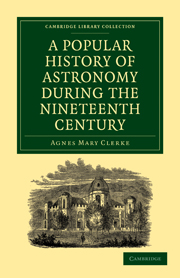Book contents
- Frontmatter
- PREFACE
- Contents
- INTRODUCTION
- Part I PROGRESS OF ASTRONOMY DURING THE FIRST HALF OF THE NINETEENTH CENTURY
- CHAPTER I FOUNDATION OF SIDEREAL ASTRONOMY
- CHAPTER II PROGRESS OF SIDEREAL ASTRONOMY
- CHAPTER III PROGRESS OF KNOWLEDGE REGARDING THE SUN
- CHAPTER IV PLANETARY DISCOVERIES
- CHAPTER V COMETS
- CHAPTER VI INSTRUMENTAL ADVANCES
- Part II RECENT PROGRESS OF ASTRONOMY
- INDEX
CHAPTER V - COMETS
Published online by Cambridge University Press: 07 September 2011
- Frontmatter
- PREFACE
- Contents
- INTRODUCTION
- Part I PROGRESS OF ASTRONOMY DURING THE FIRST HALF OF THE NINETEENTH CENTURY
- CHAPTER I FOUNDATION OF SIDEREAL ASTRONOMY
- CHAPTER II PROGRESS OF SIDEREAL ASTRONOMY
- CHAPTER III PROGRESS OF KNOWLEDGE REGARDING THE SUN
- CHAPTER IV PLANETARY DISCOVERIES
- CHAPTER V COMETS
- CHAPTER VI INSTRUMENTAL ADVANCES
- Part II RECENT PROGRESS OF ASTRONOMY
- INDEX
Summary
Newton showed that the bodies known as “comets,” or hirsute stars, obey the law of gravitation; but it was by no means certain that the individual of the species observed by him in 1680 formed a permanent member of the solar system. The velocity, in fact, of its rush round the sun was quite possibly sufficient to carry it off for ever into the depths of space, there to wander, a celestial casual, from star to star. With another comet, however, which appeared two years later, the case was different. Edmund Halley, who afterwards succeeded Flamsteed as Astronomer Royal, calculated its orbit on Newton's principles, and found it such as to give a period of revolution of about seventy-six years. He accordingly announced its probable identity with the comets observed by Peter Apian in 1531 and by Kepler in 1607, and fixed its return for 1758–59. The prediction was one of the test-questions put by Science to Nature, on the replies to which largely depend both the development of knowledge and the conviction of its reality. In the present instance, the answer afforded may be said to have laid the foundation of this branch of astronomy. Halley's comet punctually reappeared on Christmas Day, 1758, and effected its perihelion passage on the 12th of March following, thus proving beyond dispute that some at least of these erratic bodies are domesticated within our system, and strictly conform, if not to its unwritten customs (so to speak), at any rate to its fundamental laws.
- Type
- Chapter
- Information
- A Popular History of Astronomy During the Nineteenth Century , pp. 115 - 139Publisher: Cambridge University PressPrint publication year: 2010First published in: 1885



